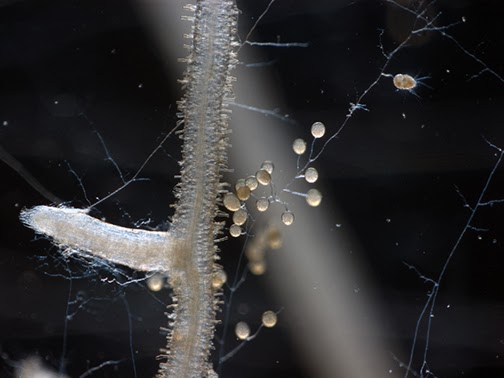Genomic analysis of an ancient companion of plants shows expanded genes for phosphorus fixation and cell-to-cell communication
The Science:
More than two thirds of the world’s plants depend on arbuscular mycorrhizal fungi (AMF, also called glomeromycota) because of their ability to fix phosphorus. By analyzing the genome of one AMF, Rhizophagus irregularis (formerly Glomus intraradices), researchers found it has expanded its range of cell-to-cell communication genes and phosphorus-capturing genes.
The Impact:
Sequencing R. irregularis has been a long and difficult effort, taking several years. This is the first AMF genome to be sequenced and could potentially impact biofuel energy and agricultural crop production by providing a better understanding of how AMF interact with plants.
Summary

Spores and hyphae (root-like extensions) of an AMF, R. irregularis, grown among carrot hairy roots. Photo by Guillaume Bécard (University of Toulouse).
A relic of fungal evolution, AMF diverged early on from other forms of fungus. They form dense clusters of branched structures — called arbuscules — in root cells, much like a tight, many-fingered handhold through which they exchange nutrients from the plant hosts they depend on to survive. AMF are adept at capturing phosphorus, a critical element for cellular function that’s otherwise difficult to extract from the soil. Scientists theorize that plants adapted their essentially rootless primordial form and developed deeper and stronger roots to take advantage of the nutrients that underground AMF fed them.
In 2006, shortly after the DOE JGI sequenced the first tree genome, Populus trichocarpa, it became apparent that it takes a village (of other organisms) to raise a poplar tree. Researchers Jerry Tuskan of Oak Ridge National Laboratory and Francis Martin of the French National Institute for Agricultural Research (INRA), recommended that the assembly of Populus-associated fungi and bacteria be sequenced to inform research on perennial plant growth, ecosystem function and plant microbe interactions. This long passage is outlined in an earlier publication in New Phytologist.
Now, a team led by led by INRA and including researchers from the Department of Energy Joint Genome Institute (DOE JGI) has reported the complete genome of R. irregularis in a paper published online November 25 in the journal Proceedings of the National Academy of Sciences (PNAS). The researchers found that through several generations, portions of the R. irregularis genome were duplicated, invaded by repeated transposable elements, famously known as ‘jumping genes’. Unlike many other fungi, R. irregularis seems to lack mechanisms that can keep these transposable elements from running amok. The expanded portions of the genome include several genes for phosphorus metabolism and genes for communication between cells via signaling proteins.
R. irregularis has also lost some genes, especially those associated with toxins other plant-interacting fungi release. The researchers speculate this avoids setting off the host plant’s immune system. R. irregularis has also cast off most of its genes for breaking down plant cell walls, a critical ability for free-living fungi that feed off dead organic matter in soils.
Learn more about fungal genomics in this video: http://bit.ly/JGI-Fungal-vid.
Contact
Igor Grigoriev
DOE Joint Genome Institute
[email protected]
Funding
- Department of Energy, Office of Science
- Oak Ridge National Laboratory Scientific Focus Area for Genomics Foundational Sciences
- National Science Foundation
- European Commission
- French National Research Agency, Clusters of Excellence ARBRE and TULIP (ANR-10-LABX-41)
- Conseil Régional Midi-Pyrénées
- Natural Sciences and Engineering Research Council of Canada
- German Federal Ministry of Education and Research
- Swiss National Science Foundation
- Italian Regional Project Converging Technologies-BIOBIT
- Ministry of Education, Culture, Sports, Science and Technology of Japan Programme for Promotion of Basic and Applied Researches for Innovations in Bio-oriented Industry
Publication
- Emilie Tisserant, et al. Genome of an arbuscular mycorrhizal fungus provides insight into the oldest plant symbiosis, PNAS 2013; published ahead of print November 25, 2013. doi:10.1073/pnas.1313452110
Related Links
- DOE JGI news release: http://bit.ly/JGI-Glomus
http://www.pnas.org/content/early/2013/11/21/1313452110.abstract?sid=0c8b4e4c-ad03-4d45-879c-d28b304a0c53
http://mycor.nancy.inra.fr/ARBRE/